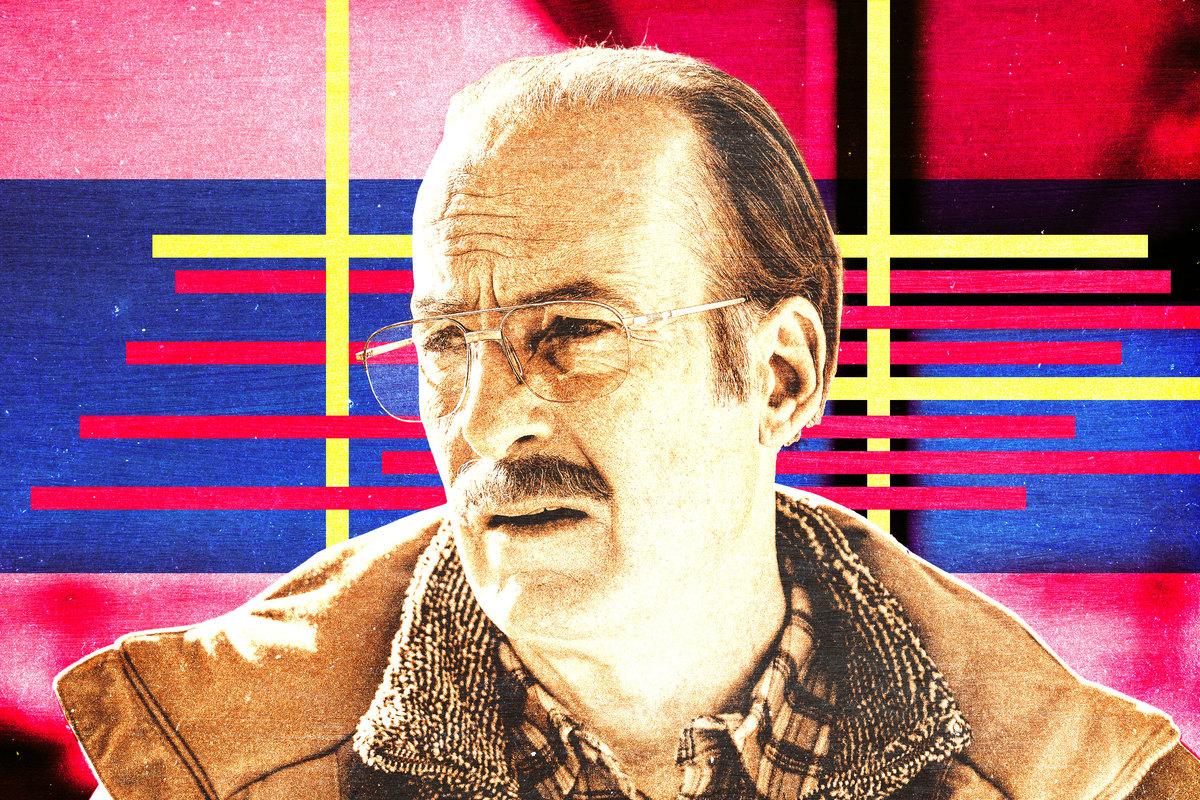‘Better Call Saul’ and ‘Breaking Bad’ Have Never Been More Intertwined
As ‘Better Call Saul’ bleeds into the events of ‘Breaking Bad,’ familiar faces return in unexpected circumstances

When Saul Goodman first appeared in the second season of Breaking Bad, the episode got its title from the tacky tagline for his law practice: Better Call Saul. At the time, nobody would’ve expected the character—or the catchphrase—to have such a long shelf life. As Bob Odenkirk told me last year, a cameraman said he wanted a job on the Saul spinoff when they were filming the episode, but it was nothing more than an on-set gag. (Saul was intended to have only a three-episode arc on Breaking Bad.) Now, 13 years since the character’s debut, Better Call Saul has completed the inverse: an episode named after its predecessor.
As expected, the antepenultimate episode of the series, “Breaking Bad,” sheds new light on some of Saul’s actions in, well, Breaking Bad. As a result, Better Call Saul has finally delivered the highly publicized return of Walter White and Jesse Pinkman—bringing the audience back to the moment when the duo first required Saul’s services as a “criminal lawyer.” In other words, just as Better Call Saul starts bleeding into Breaking Bad, the episode “Breaking Bad” informs prior events in “Better Call Saul.”
With the name of the episode generating its own news cycle over the past week, the thrill of Better Call Saul revisiting the Breaking Bad timeline speaks for itself. But Better Call Saul isn’t the kind of series that simply panders to nostalgia—like the many scams Jimmy McGill has orchestrated, every detail is deliberate. In the case of “Breaking Bad,” a trip down memory lane echoes potentially destructive events in the show’s Cinnabon-glazed present, with Gene Takovic succumbing to the same vices that ruined his previous lives.
After teasing Walt’s and Jesse’s cameos by opening with Saul tied up in the back of their RV, a sequence that vaguely name-dropped Nacho Varga and Lalo Salamanca in “Better Call Saul,” the episode switches to black-and-white for a post–Breaking Bad check-in with Francesca Liddy. No longer Saul’s overworked secretary, Francesca is a small-time landlord who deals with stoner tenants clogging sinks with seeds and stems. (Obviously, she’s handled much worse at the law office and doesn’t tolerate any of their bullshit.) We then follow Francesca as she journeys to a deserted pay phone and answers a call from Gene—in exchange, he tells her where he stashed a small bundle of cash. “I still get followed, not as often as when the shit first hit the fan, but I still see them,” Francesca tells Gene, referring to the feds who are still gunning for him. “My mail gets opened, my phone at home clicks whenever I use it.”
As Francesca explains, authorities have zeroed in on Saul as the last person from Heisenberg’s operation who can be apprehended after Jesse’s car was discovered at the border. (The dude went through hell in El Camino to reach freedom in Alaska, so he deserves it.) What’s more, the businesses Saul used as shell companies have been seized—the only other money he’s got left to his name is what he brought with him to Nebraska. If Gene was expecting the heat to die down on Saul, his chat with Francesca underscores that everything remains at a boil. But Francesca saves arguably the biggest news for last, at least from the perspective of fans. “I did get one call, after everything went down,” she says. “Kim, checking in on me.”
Not that anyone would’ve expected Kim to die off-screen, but the confirmation that she’s alive is nevertheless reassuring. Kim also asked Francesca what happened to Saul, which gives Gene enough of an impetus to try to reach out to her. Apparently, he already knows Kim moved to Titusville, Florida, where she works at a place called Palm Coast Sprinklers. (For anyone curious about Titusville in relation to the rest of Florida, Kim basically lives next to the Kennedy Space Center, which, in my headcanon, means she checks out NASA rocket launches in her free time.)
While it appears Gene reaches Kim through the pay-phone operator, viewers don’t get a chance to hear their conversation. Instead, we see Gene wildly gesticulating in the phone booth and getting worked up over whatever’s said on the other line. In a fit of rage after hanging up, he smashes the booth’s glass. (It’s another way Better Call Saul comes full circle: The first time Jimmy and Kim shared the screen in the series premiere, he kicked an HHM parking lot trash can so hard it left a sizable dent.) No matter how much time has passed under different identities, it’s clear the pain of losing Kim feels as raw for Jimmy as it did the day she left him. And if a full-blown transformation into Saul was how Jimmy processed their breakup in the prequel timeline, it doesn’t bode well for Gene in the present.
After the temper tantrum, Gene’s first order of business is reuniting with the elderly Marion at her home, where he once again ingratiates himself to her by pulling up funny cat videos on YouTube. (Protect Marion at all costs.) Understandably, Jeff the cabbie is confused and a little intimidated by Gene showing up after he stressed in last week’s episode that they’d never see each other again. But with the help of Jeff and his buddy—whose name, in fact, is Buddy—Gene’s got a new scheme in mind that will give the trio a steady flow of [Clears throat.] supplemental income.
The new grift starts with Gene looking for a specific mark at a bar: a single man who lives alone and has some money to his name. Under the alias Victor, Gene gets the person drunk while he funnels his own drinks through a rubber hot water bottle tucked under his shirt. From there, Gene will lead the man to Jeff’s cab, where they’re offered a complimentary bottle of water that’s been laced with a sedative. Once Jeff escorts the person to their home, he puts duct tape where the front door would shut. After the guy passes out from a combination of the booze and spiked water, Buddy enters their home to take photos of all the confidential information he can find: their driver’s license, credit cards, tax forms, and so on. Finally, the information is sold on the black market. In essence, Gene’s new scam is a very roundabout way of committing identity theft.
Better Call Saul delivers another stellar (final?) montage to add to its superlative collection by showing the many victims Gene suckers with the identity scam. And the longer Gene and his new lackeys keep the scheme going, the more he feels comfortable slipping back into the familiar comforts of Saul Goodman. Gene buys the same foot massager he used to have in his law office—which was also immortalized as one of Better Call Saul’s alternating title sequences—gets a new Bluetooth headset, and starts hiring sex workers. Really, all that’s missing from the old days are the colorful suits.
With how much Gene is reliving his past life, it’s only fitting the episode intermittently rewinds to Breaking Bad. The long-awaited Walt and Jesse reunion takes place in the RV after Saul agreed to help them get Badger out of a sticky situation in “Better Call Saul.” (For anyone needing a refresher, Badger was arrested after selling meth to an undercover cop in Season 2.) The scene mostly revisits some of Breaking Bad’s greatest hits—namely, our favorite New Mexico meth cooks bickering like an old married couple. But as Saul observes the RV setup, he puts the pieces together that Walt and Jesse are responsible for the blue meth that’s been all the buzz on the street. He doesn’t know their names yet, but the fact that Walt and Jesse make quality product from such a crappy setup only endears them to Saul.
His curiosity piqued, Saul gets Mike Ehrmantraut to dig into the man he deduces to be Heisenberg. (As far as the timeline is concerned, Mike’s appearance in “Breaking Bad” precedes his on-screen debut in Breaking Bad.) Mike, in turn, lays out the bullet points for Saul: Heisenberg’s real name is Walter White, he’s a high school chemistry teacher, and he’s got stage 3 lung cancer. From Mike’s perspective, even if he wasn’t dying, Walt wouldn’t be worth the trouble. “You see an amateur,” Saul retorts. “I see 170 pounds of clay ready to be molded.”
Saul’s importance to Heisenberg was already established in Breaking Bad, where he effectively acted as a middleman for Walt’s introduction to Gus Fring and gave Walt the tools to launder money for his growing meth empire. But “Breaking Bad” shows how much of that partnership was spurred by genuine intrigue. From his days as Jimmy McGill, we know Saul has a soft spot for the little guy—the kind of people belittled and underestimated by those around him, much like he once was by his brother for becoming a lawyer. Beyond the promise of his meth operation, perhaps Saul sees something of a kindred spirit in Walt. (If nothing else, they can certainly relate to embracing multiple identities.)
How this all ties back to Gene’s latest grift in Nebraska is a bit more abstract. Gene chats up another mark at a bar who pulls out a bunch of pills and divulges that they’re for his cancer treatment. Shocked by the admission, the humanity of the old Jimmy creeps out from behind the facade. “Hey, it’s none of my business but should you be drinking?” Gene asks the man, who seems resigned to what’s implied to be a terminal diagnosis. You can see the wheels turning in Gene’s head, and for a brief moment, there’s hope he has enough moral fiber to prevent himself from scamming someone with cancer. Nevertheless, he walks the mark to Jeff’s cab, completing his end of the scheme.
But while Gene had enough resolve to continue the scam, Buddy isn’t so willing. Recognizing the type of pills from his late father’s bout with cancer, Buddy leaves the man’s home without taking any photos of his personal information. One missed opportunity doesn’t erase all the money they’ve collected from previous victims, he argues. But Gene is so irate that he fires Buddy on the spot and demands Jeff drive him back to the man’s home. Never mind that Buddy already removed the duct tape from the door—or that it’s been hours since the sedative took effect—he wants to finish the job.
To say Gene doesn’t treat his new henchmen with much empathy would be an understatement. Instead, he’s carrying himself with the same spiteful air of superiority that Heisenberg once did—you get the sense Gene believes he’s above the schemes he’s pulling off in Nebraska after the heights he reached in New Mexico. Setting aside that Gene wants to scam someone with a cancer diagnosis, the Breaking Bad parallels bring to mind Walt’s decision to return to New Mexico instead of hiding away in New Hampshire at the end of the series. Rather than wither away outside of the spotlight, Heisenberg opts to go out in a blaze of glory.
While Gene’s actions are more benign than anything Walt ever did—scamming isn’t legal by any means, but it beats cooking meth and literally killing people—there’s clearly a part of him that wants recognition as much as self-preservation. (Even in the Gene flashbacks from previous seasons, his palpable fear of being caught clashes with a moment when he carves “S.G. was here” in the mall’s garbage room.) Better Call Saul has largely separated itself from Breaking Bad by being an understated character study of a sympathetic con man, but in its endgame, Gene is primed to blow up his life because of the same loneliness, resentment, and pride that once felled Heisenberg.
The feeling of history repeating itself is brilliantly conveyed in the closing moments of “Breaking Bad,” which cuts back and forth between Gene’s impulsive desire to finish the scam and Saul’s going against Mike’s advice to meet with Walt at J. P. Wynne High School. When Saul first saw the potential in Walt and offered to be his intermediary to New Mexico’s criminal underworld, he never could’ve foreseen how one choice would lead him down a path of destruction. But with Gene threatening to ruin what he’s quietly built in Nebraska over the smallest of setbacks, it’s as if the Breaking Bad universe is folding in on itself. True to the episode’s weighty title, as we reach the end of Better Call Saul, our morally conflicted antihero is still breaking bad.

